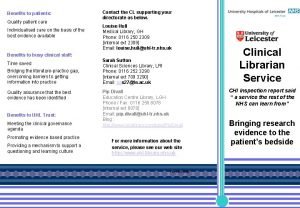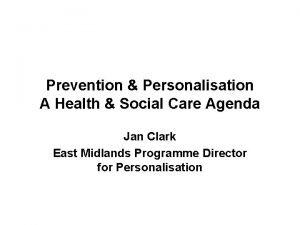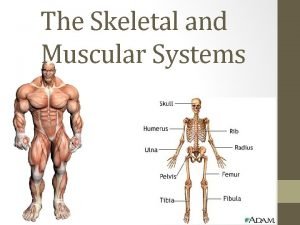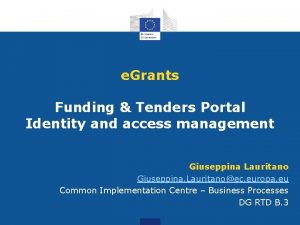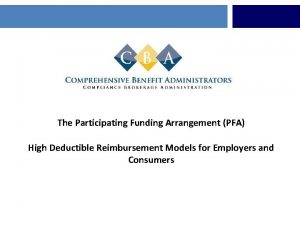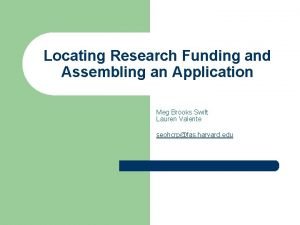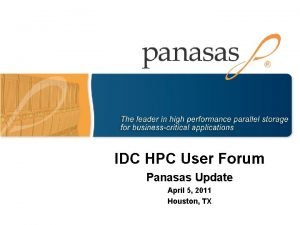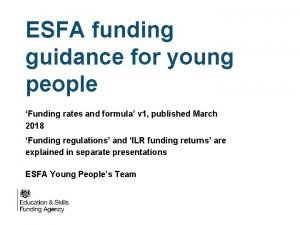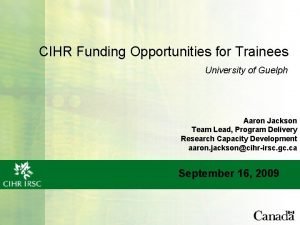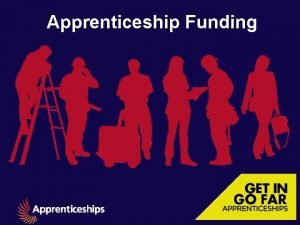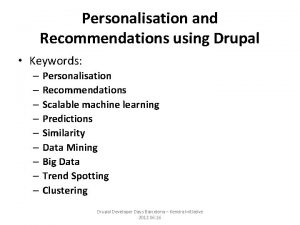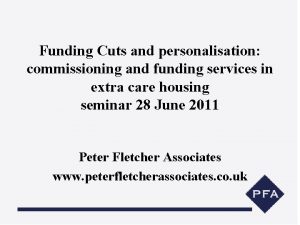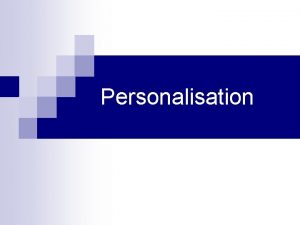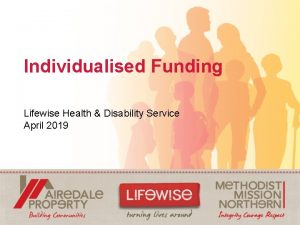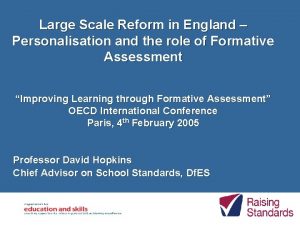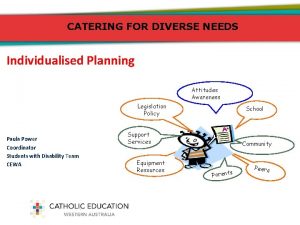Individualised Funding and Personalisation in England What Worked


































- Slides: 34

Individualised Funding and Personalisation in England: What Worked, What Didn’t, and Why. Rob Greig Chief Executive: NDTi

About NDTi and me • An independent not for profit social change agency • Concerned with disability and also ageing • Policy development, research, change support, demonstration projects. • I previously worked in and managed both NHS and local government services • Prime author of Valuing People – the English Government’s learning disability policy 2001 - ? ? ? • Government National Director for Learning Disability 2001 – 2008 • Head of NDTi since 2008.

The roots of individual or personal budgets • The fight of people with disabilities for self-determination (in particular the introduction of direct payments) • The initiatives arising from the Valuing People White Paper around person centred approaches and the creation of ‘In Control’ • The growing recognition from inspection and regulation of the poor quality and value for money of many public services

The Process of Policy Commitment

How do I feel about personalisation and personal budgets nowadays?

Some Core Starting Points: The Gift Model of support

An alternative approach that underpins personalisation

Gthe four components of personalisation

How Personalisation and Personal Budgets Fit Together

In Control’s 7 principles of Self Directed Support • Right to Independent Living – “I can get the support I need to be an independent citizen” • Right to a personalised budget – “I know how much money I can use for my support” • Right to self-determinisation – “I have authority, support and representation to make my own decisions” • Right to accessibility – “I can understand the rules and systems and can get help easily” • Right to Flexible funding – “I can use my money creatively and flexibly” • Accountability principle – “I should tell people how I have used my money and anything I have learnt” • Capacity principle – “Give me enough help, but not too much; I’ve got something to contribute too”

What Are Individual or Personal Budgets? They are a way of making Personalisation happen People are: ① Supported to plan their own lives ② Told how much money is available to support them ③ Supported to develop a plan about how to use the money ④ Given control of the money if they want ⑤ Provided with what they want – not what suits services best

1. People are supported to plan their own lives • The starting point is what people want in their lives – not a deficiency model of what people cannot do • Planning is led by the person, not by a care manager or health professional • A ‘social capital’ mindset is needed – exploring how people can live as part of their community

2. People are told how much money is available to support them • The principle is that if people know what money is available – they will use it wisely and get better outcomes • A local formula is designed (The Resource Allocation System – RAS) • The system starts from considering the support people need, not the disabilities they have

3. People are supported to develop a plan about how to use the money • People decide themselves how best to meet their needs • The obligation is to show that support / services contribute to that – not that a service is acceptable to the Local Authority • People will need support (e. g. brokerage) to explore new and different options to spend their money on

4. People are given control of the money if they want • If a person wants complete control – then a direct payment can be given (for social care money) • If they want minimal involvement – the local authority continues to organise the supports – but based on what the person says they want • In between are systems of Trust Funds, family support etc. • Access to high quality independent support around managing the whole process is essential

5. People will be provided with what they want – not what suits services best • The evidence and assumption is that people will want to use the money to buy different things • A requirement to buy back into existing services is not part of true personalisation • Many new support options will be ‘mainstream’ services outside the traditional social care framework • It doesn’t have to be something recognisable as a service (e. g. the football season ticket story)

The early Evidence of Personal Budget Effectiveness Desired change Number Made it Where I live 17 76% Who I live with 16 81% What I do with my time 26 69% Who supports me 18 89% Other specific changes 10 90% Total 87 79%

The early Evidence of Personal Budget Effectiveness Satisfaction Rates Selfdetermination Before After 42% 97% Planning 61% 97% Money 45% 90% Home 65% 94% support 48% 100% 67% 100% 56% 100% 61% 100% Community life (family-based) Community life (non-family) Community life (overall)

With moderate growth, the picture was still positive and cost effective…

…including for aspects of people’s health

Where are we in 2017? • Many positive stories of people’s lives improving through use of personal budgets – with evidence around those people being compelling • But the positive impacts are being felt by a minority of people • Overall the idea has lost a lot of credibility and much of what is claimed is not backed up by reality and evidence • A nagging belief that it works for people who are articulate, or well advocated for by families or others.

What’s the picture like nowadays? • From the 2016 POET survey (8, 000 people) • Two thirds of respondents said a PB had made things better or a lot better in 11 of 15 life outcome areas • Over 80% said a PB had made things better or a lot better in terms of dignity in support and quality of life • Keeping the process simple is important – those who found it simple were three times more likely to report good outcomes

A view from the seat of Government When implemented well, personal budgets allow adults to try new ways to meet their social care needs, give them more choice and control over the care they receive and give them the opportunity to achieve the outcomes they want from their care. The Department of Health has demonstrated the potential of personal budgets to transform care and improve quality of life for most groups of social care service users but it is not doing enough to ensure that all can reap the benefits and it has not set out how it will judge success. We are not assured that local authorities can fully personalise care while seeking to save money and are concerned that users’ outcomes will be adversely affected. Local authorities face a substantial challenge supporting sustainable local care markets which over the diverse range of provision needed for users to personalise their care, while care providers are struggling to recruit and retain appropriately qualified staff as financial pressures increase. House of Commons Public Accounts Committee 2016

A view from over the border Audit Scotland report on self-directed support in 2017 reported: • “There is a growing body of evidence that selfdirected support is helping many people with support needs to live more fulfilled lives” • “However, there is no evidence of the transformation required to fully implement the policy” • The most substantive progress has been made in rural parts of Scotland.

Most recent data from Scotland (2015/16) • At least 53, 500 people made informed choices regarding their services and support – roughly 27% of all adults receiving nonresidential care • 11% chose a direct payment • 9% chose budget managed by others • 75% chose service managed by the authority • 5% chose a combination of the above

Learning disability data from a typical English Local Authority (2017) • 432 Personal Budgets overall • Of these, 347 are notional PB arrangements i. e. the person is told the amount of the Personal Budget but the Council effectively takes decisions on its usage • 37 are 3 rd party Personal Budget arrangements • 48 are Direct Payment Personal Budget arrangements

Where did it start to go wrong? (1) Government set a target for the proportion of people who would have a personal budget. • Hitting the target became all that mattered • A flexible definition of personal budgets meant that most were not ‘real’ • Council’s pretended personal budgets existed when they did not • No-one really checked on Council honesty (the regulator no longer inspects local authority social care)

Where did it start to go wrong? (2) Purchasing responsibility was passed to the person without proper support • Real brokerage rarely exists, so there is no support to work out what you want • Investment in advocacy and family support is being substantially cut • Local authorities are not taking market development seriously, so choices can be limited • Many authorities are applying arbitrary rules, that limit what people can do and constrain support planning

Where did it start to go wrong? (3) People forgot about community inclusion and social capital • It became more about how to reorganise service delivery…. . • … and save money at the same time • Real life outcomes like getting a job almost never appeared in support plans • Professionals found it difficult to leave behind a deficit model when doing assessments and reviewing support plans This was significantly because of …….

Where did it start to go wrong? (4) Austerity and financial cuts • Too often its implementation was being done alongside service cuts • Cuts meant that some Councils and social workers thought that only “personal care and safeguarding matter” • Funding for brokerage, advocacy etc, disappeared • Posts to support people to understand implement personalisation stopped existing

A summary of personalisation in England • Some people are getting great new opportunities and lives because of it • A small minority of people feel additional burdens have been put on them that they do not want • For most people, the systems around them have changed but they don’t experience much that is different as personal budgets exist primarily on paper • Beyond personal budgets (remember the four elements) the wider move to personalisation has stalled because of austerity and service cuts A great vision obstructed by poor leadership and austerity

Don’t Take This The Wrong Way Personalisation and Personal Budgets really can work and make a difference – if: • People get proper support through brokerage and advocacy • Social capital and community inclusion are at its heart • People are doing it through choice rather than being forced to – no hard targets • Local authorities support effective market development • Professional believe in it and will give up power • Services receive the necessary investment

The Catch 22 • For most people, personal budgets have made little difference • It has become a process that Council’s feel they have to do, a tick box rather than real outcomes • It has become linked in many people’s minds to financial cuts BUT • For some people, life really has improved, and • They’ve more control over their lives and services, and • There has been some genuine financial savings So what do we do? We cannot go back, but a great idea is significantly discredited, observed in name but not deed and the full vision is probably not attainable. Where now?

Thank you! www. ndti. org. uk @ndtirob ndti. org. uk
 Individualised education
Individualised education Individualised patient care
Individualised patient care Sitecore adaptive personalisation
Sitecore adaptive personalisation Personalisation agenda 2018
Personalisation agenda 2018 Lexical grammar test
Lexical grammar test Goodrich method of flood routing
Goodrich method of flood routing His shoulders globed like a full sail strung
His shoulders globed like a full sail strung Guillaume de machaut worked primarily in
Guillaume de machaut worked primarily in How feudalism worked
How feudalism worked John hopkins essays that worked
John hopkins essays that worked Chemsheets
Chemsheets Reported speech exercises
Reported speech exercises Josquin desprez was a contemporary of
Josquin desprez was a contemporary of It was such a foggy day that we couldn't see the road
It was such a foggy day that we couldn't see the road Arm extension muscles
Arm extension muscles Type 3 conditional
Type 3 conditional How to find area of a sector with radians
How to find area of a sector with radians How the body works answer key
How the body works answer key Worked out
Worked out 1. what was the ghazu? what was the ummah?
1. what was the ghazu? what was the ummah? Worked out
Worked out Funding and tenders portal
Funding and tenders portal Funding requirements and source of funds
Funding requirements and source of funds England and scotland both produce scones and sweaters
England and scotland both produce scones and sweaters England france map
England france map Participating funding arrangement
Participating funding arrangement Overview funding programmes
Overview funding programmes Hcrp summer funding
Hcrp summer funding Panasas funding
Panasas funding Garuda aerospace private limited
Garuda aerospace private limited Esfa funding
Esfa funding Cihr funding opportunities
Cihr funding opportunities Cape funding list
Cape funding list Unit 5 operating your business lesson 1 funding sources
Unit 5 operating your business lesson 1 funding sources Apprenticeship funding bands
Apprenticeship funding bands

